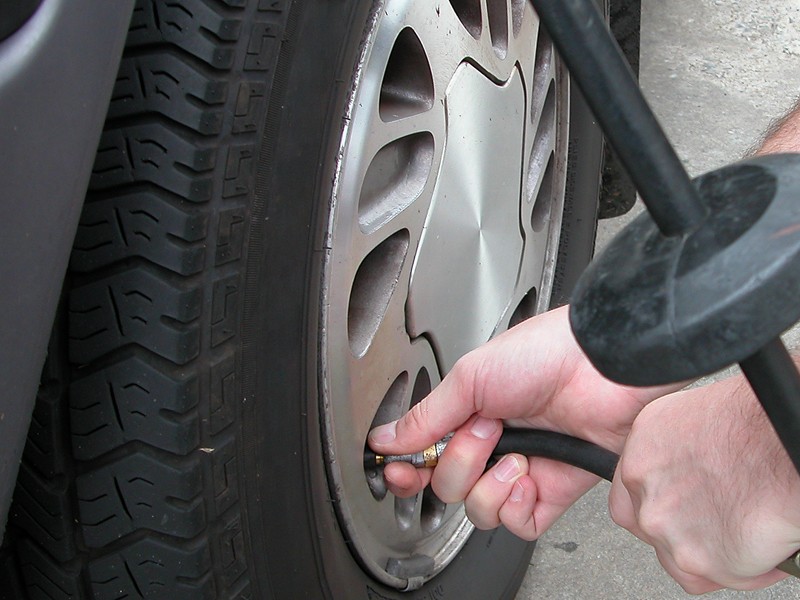Tire pressure warning lights are the cars’ way to let you know that there is something wrong with your tire. When you see the tire pressure warning light flashes, consider it as an alert that a fault is detected by the system. You can usually see the tire pressure warning light along with the other gauges on your car’s dashboard.
When you see your tire pressure warning light flashes, it is best that you take heed of it and do what your car wants you to do. A thorough understanding about tire pressure warning lights, what it means and how to deal with it can help you avoid dangerous situations.
Tire Pressure Warning Lights: What does it mean when it lights up?
A car has a Tire Pressure Monitoring System which is designed to monitor the air pressure inside your tires. Its task is to warn you when it senses that one or more of your tires are underinflated or overinflated. You will know this when the tire pressure warning lights light up. It is the yellow tire cross-section symbol with an exclamation point on your dashboard. For some, it might look like an exclamation point in the middle of a horseshoe.
Although your car’s tire pressure monitoring system or TPMS alerts you when your tire has low air pressure when the tire pressure warning light flashes, it does not replace your regular tire maintenance schedule and the regular tire pressure checks.
The tire pressure monitoring system is only a tool that can help alert you and it is only limited to that. Depending on the circumstances or the car you drive, the TPMS’ can only do what it is set up to do. Like to illuminate when below the tire pressure that is needed to carry the vehicle load or it only lights up when your air pressure is either too high or too low. A tire air pressure may drop way below the appropriate inflation before the TPMS detects it and sets off your tire pressure warning light.
Proper tire maintenance on a regular basis should always be done with or without the illuminating tire pressure warning lights. It is important because there are instances where the TPMS sensor gives incorrect tire pressure data to the car’s computer. In addition, the system might not be able to determine accurately if tire pressure is too low and if the other tires are losing the same amount of pressure simultaneously. That is why you still have to do your part and check your tires regularly and not wait until your tire pressure warning light lights up.
Tire Pressure Warning Lights: What causes it to light up?
A flashing tire pressure warning light can be caused by any of these factors.
- You have low tire pressure.
Like mentioned earlier, a tire with low air pressure can set off your tire pressure warning lights. It is because a tire with low air pressure can lead to unsafe driving conditions. It can increase the rate of wear or cause premature treadwear and a possible tire failure. An underinflated tire can also cause poor fuel economy, a slower tire response, tire overload, and excessive heat build-up.
The tire pressure warning light usually lights up when your tire has an air pressure below 75% of the recommended specifications of your car to give you enough time to correct it. Typically, a tire pressure warning light that is triggered by a tire with low air pressure can be seen illuminating when you are driving.
- Ambient temperature change.
If you notice that your tire pressure warning light goes on and off, it might be because of fluctuating temperatures. Cold air is denser than warm air and the tire pressure warning light can be set off by a drop of pressure overnight when the ambient temperature drops. During the day when the ambient temperature is rising or when your car starts to warm up as you use it, the pressure is also increasing and you might notice the illuminating tire pressure warning light go off.
In a situation like this, it is recommended that you double-check all of your tires’ air pressure. Use a tire pressure gauge to check each of your tires and add air when a tire is low.
- Faulty tire pressure monitoring system sensor.
A tire pressure warning light that has been flashing for 60 to 90 seconds every time you start your car and continues to illuminate can be an indication of a faulty tire pressure monitoring system. You can also refer to your car’s manual since every car is different.
When you see the flashing tire pressure warning light, it is still best to check all of your tires’ air pressure to be sure. But if the TPMS sensor is indeed faulty, you need to have it checked immediately and have it fixed. With it being out of order, it won’t be able to warn you if you have low tire pressure.
- Your tire has something on it.
If you already checked your tires’ air pressure and have corrected it but you still see the flashing tire pressure warning light, then there must be something wrong with your tire. Check your tires and look for any nails or sharp items poking out. A small puncture or a leak might be the one causing the tire pressure to go down even after filling it up, triggering the tire pressure warning light.
Tire Pressure Warning Lights: Can I drive with tire pressure light on?
When you notice that your tire pressure warning light is illuminating, do not ignore it. For people that are asking if they can drive their cars with their tire pressure warning lights on, the answer is no. It is not safe to drive a car with an illuminating warning light. This is because your tires are either underinflated or overinflated and driving with tires like these can cause problems and can compromise your safety.
You can refer to the owner’s manual of your car to know the correct tire pressure of your tires and for specific instructions on how to monitor your car’s tire pressure monitoring system.
If you insist on driving a car with a flashing tire pressure warning light, it can lead to wear on the tire that can cause tire failure or a blowout that can harm you and other motorists on the road. Driving with an underinflated tire can also cause unpredictable vehicle handling, poor fuel economy, and will reduce the lifespan of your tires.
The best way to deal with illuminating tire pressure warning lights is to pull over, check your tire pressure using a tire pressure gauge, go to the nearest gasoline or service station, and add the appropriate amount of air. Once the tires are all set and have the correct tire pressure, the light will go off after you’ve driven for a few miles.
Tire Pressure Warning Lights: Why is my tire pressure light on when my tires are fine?
If you have inspected your tires and filled it up with the right pressure but for some reason, the tire pressure warning light is still illuminating, it might be caused by a different issue like a faulty tire pressure monitoring system.
Other factors that can set off the tire pressure warning lights include:
- Extreme cold weather.
It is known that the tire pressure goes down in extremely cold weather even if you filled your tire with the correct pressure. The condition usually disappears when the temperature rises and the car and tires warm up.
- You’re using a spare tire.
Spare tires don’t usually have TPMS sensors that can be detected by the TPMS. This can cause your tire pressure warning light to set off. For spare tires that have sensors and you have an illuminating warning light, it can be because you have failed to check the spare tire’s air pressure.
- You just had a tire replacement.
It is important that you check your pressure light when you change a tire since TPMS can get damaged in the process. In order for it to work, the TPMS should be on the tire’s rims.
- Weak TPMS sensor batteries.
The TPMS sensor is powered by its batteries. These batteries are expected to last anywhere from five to ten years. Some batteries could last within that window and some fail even sooner. It really depends on the number of radio frequency transmissions the sensors make, how much driving you do, and the conditions you drive in like the weather or temperature.
Weak TPMS sensor batteries can lead to a signal interruption and it causes your tire pressure warning lights to set off and flash. You can replace the sensor batteries to correct it.
If a dead sensor battery causes one sensor to fail and will need a sensor replacement, you can replace that one, faulty sensor. But it is recommended that when you replace one faulty sensor, you should replace all the other TPMS sensors as well. It is because it is likely that the other sensors are close to failing, too. It will be convenient for you to have the sensors replaced all at once so you won’t have to go back to the service shop when the other sensors start to fail.
Tire Pressure Warning Lights: How do I get the TPMS light to go off?
For you to turn off your flashing tire pressure warning lights, you will need to do any of the following: 1.) check your tire pressure and correct it, 2.) replace faulty or damaged sensors and dead batteries, or 3.) reset the system.
How to reset your car’s TPMS?
Before you decide to reset your car’s TPMS, keep in mind that resetting it should only be done as the last resort. It should only be done after you have checked your tires and crossed out all other possible causes of an illuminating tire pressure warning light.
To reset your TPMS, follow these simple steps:
- Turn your key to ON position without starting your car’s engine.
- Locate the TPMS reset button. It is usually located under your steering wheel. Look for a button with a “SET” marked on it. If you can’t locate it, refer to your owner’s manual to know where you can find the button since its location may vary depending on the model or brand of the car you own.
- Press and hold the TPMS reset button for about three seconds and then release it. Your system will start to beep or you may notice your warning light blink three times on the dashboard. This would mean that your TPMS has been reset.
- Start the engine five seconds after the beep or blink.
- Drive your car around for at least thirty minutes to end the reset procedure. If you want to drive around for more than thirty minutes, you can do so.
- If the tire pressure warning light still lights up after doing the reset, visit your nearest service shop to diagnose the problem.
Resetting your tire pressure monitoring system should only be done when necessary, only after you fixed all the possible problems that triggered it. It should not be done as a habit every time your tire pressure warning light illuminates.
Tire Pressure Warning Lights: Final Word
A tire is the only car part that has direct contact on the ground. That is why you need to take care of it and make sure that it is not overinflated and underinflated. When it is, the consequence will cause you trouble. For this reason, your car has been equipped with the TPMS with a tire pressure warning light that illuminates when a fault in your tire is detected.
The tire pressure warning lights simplify your work. It is important that you pay attention to the warning light and don’t ignore it when it starts to flash. It can save you, your family, and other motorists and pedestrians on the road.



